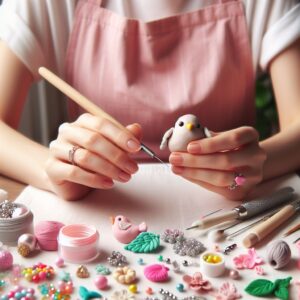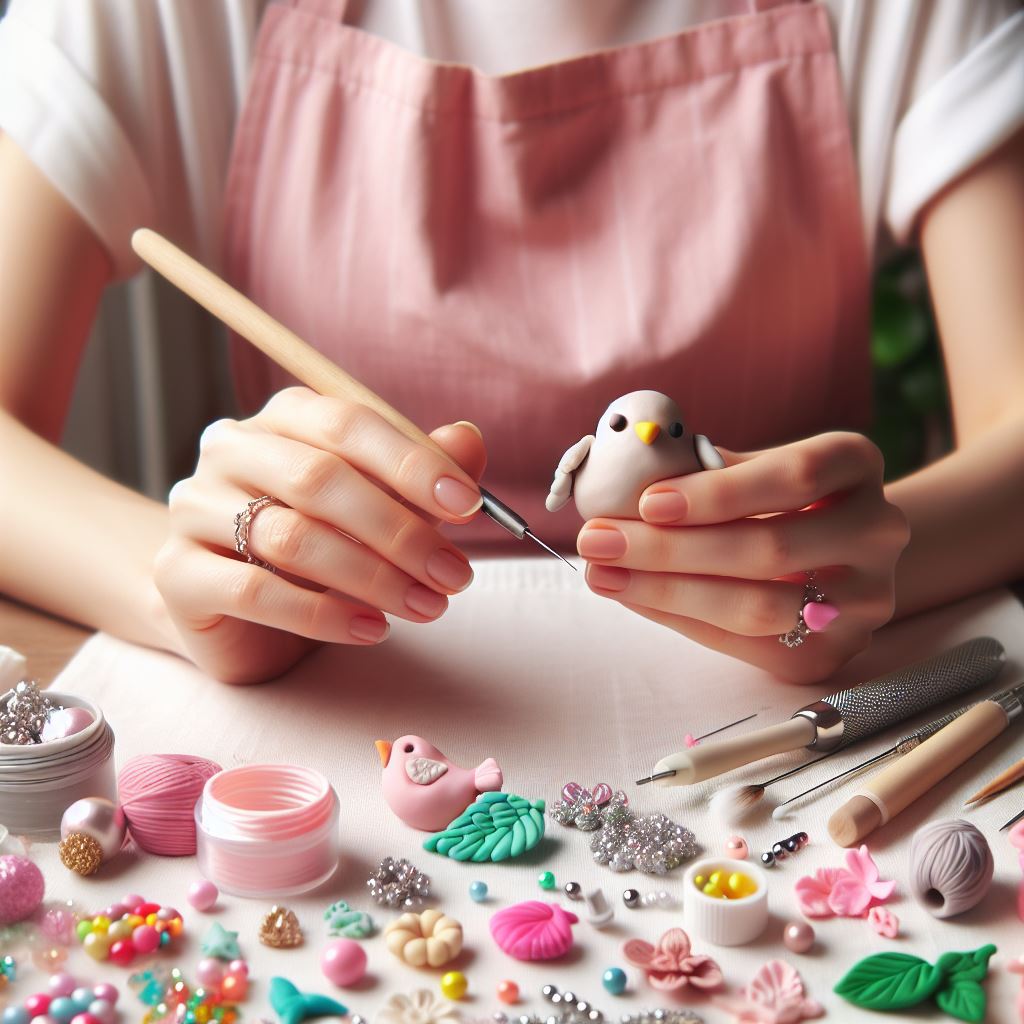Table Of Contents
- 1 An Introduction to Polymer Clay Sculpting
An Introduction to Polymer Clay Sculpting

Polymer clay sculpting offers an accessible and versatile art form for individuals of all ages and skill levels. This oven-bake clay provides endless creative possibilities, allowing you to mold, sculpt, and color your imagination into tangible form.
Unlike traditional air-dry clays, polymer clay remains pliable until baked, affording the luxury of time and flexibility. This characteristic makes it ideal for beginners, as mistakes can be easily corrected, and projects can be paused and resumed at your convenience.
Beyond its user-friendliness, polymer clay boasts a multitude of benefits that make it a compelling medium for artistic expression:
- Durability: Once baked, polymer clay becomes remarkably tough and resilient, making it suitable for creating durable objects like jewelry, figurines, and home décor items.
- Vibrant Colors: Polymer clay comes in a vast array of vibrant colors, allowing you to create stunningly realistic or fantastical creations. You can even mix colors to achieve custom shades and unique effects.
- Versatility: The clay’s pliable nature allows for a diverse range of sculpting techniques, from simple pinching and shaping to intricate molding and texturing.
- Lightweight: Baked polymer clay is surprisingly lightweight, making it ideal for creating earrings, necklaces, and other wearable art pieces.
- Affordability: Compared to other sculpting materials like bronze or ceramic, polymer clay is relatively affordable, making it a budget-friendly option for beginners and hobbyists.
Whether you’re a seasoned artist or a curious beginner, polymer clay sculpting offers a rewarding and enriching artistic experience. Its accessibility, versatility, and stunning results make it a perfect medium for unleashing your creativity and bringing your vision to life.
Unpacking “Polymer Clay Sculpting”
As we continue our exploration of polymer clay sculpting, let’s delve deeper into the meaning of this term and deconstruct the various elements that make it a unique and captivating art form.
Polymer clay, also known as oven-bake clay or modeling clay, is a type of synthetic sculpting material that remains pliable until exposed to heat. This allows for extensive manipulation and shaping, offering greater flexibility and control compared to air-dry clays.
The “sculpting” aspect of polymer clay emphasizes the process of molding and shaping the clay into desired forms and figures. This can involve various techniques, from simple pinching and rolling to more advanced sculpting methods like coil building and slab construction.
When combined, these elements create the dynamic and multifaceted art form known as “polymer clay sculpting.”
Here’s a breakdown of the key components:

- Material: Polymer clay is a versatile and forgiving material, allowing for countless creative possibilities.
- Process: Sculpting involves shaping and manipulating the clay to create desired forms and figures.
- Tools: Various tools can be used to enhance the sculpting process, including knives, rolling pins, texture mats, and sculpting blades.
- Techniques: A wide range of techniques can be employed, from beginner-friendly methods like pinching and poking to advanced techniques like creating molds and using armatures.
- Creativity: Polymer clay sculpting is ultimately about expressing your unique vision and unleashing your creative potential.
By understanding the individual elements and their interplay, you can gain a deeper appreciation for the art form and its potential to inspire and empower individuals of all ages and artistic backgrounds.
Tools, Techniques, and Resources for Polymer Clay
With a clear understanding of the essence of polymer clay sculpting, let’s embark on your creative journey by exploring the essential tools, techniques, and resources that will equip you to shape your artistic vision.
Essential Tools:
- Sculpting knives and blades: Used for cutting, shaping, and detailing the clay.
- Rolling pins: Used for rolling out clay to create flat sheets for slab construction or adding textures.
- Texture mats and stamps: Used for imprinting various textures and patterns onto the clay surface.
- Ribs and spatulas: Used for smoothing surfaces, blending edges, and creating gentle curves.
- Brushes and sponges: Used for applying washes of color, creating smooth textures, and blending.
- Needle tools: Used for poking holes, creating dots, and adding finer details.
- Armatures: Used as internal support structures for larger sculptures.
Fundamental Techniques:

- Pinching and rolling: A basic yet versatile technique for shaping simple forms and figures.
- Coil building: Creating long coils of clay and joining them together to build up volume and form.
- Slab construction: Rolling out clay into flat slabs and then cutting, shaping, and joining them to create various forms.
- Molding: Using molds to create identical shapes or textures on the clay surface.
- Texturing: Adding textures to the clay surface using tools, stamps, or other objects.
- Blending and smoothing: Creating seamless transitions between different clay pieces or textures.
- Coloring: Mixing various polymer clay colors to achieve custom shades and effects.
- Baking: Baking the clay according to the manufacturer’s instructions to harden it permanently.
Resources for Learning and Inspiration:
- Online tutorials: Numerous websites and YouTube channels offer free and paid tutorials on polymer clay sculpting techniques.
- Books and magazines: Many books and magazines are dedicated to polymer clay sculpting, offering detailed instructions, project ideas, and inspiring artwork.
- Workshops and classes: Participating in workshops and classes provides hands-on learning, expert guidance, and a supportive community of fellow polymer clay enthusiasts.
- Online communities and forums: Engaging with online communities and forums allows you to connect with other polymer clay artists, share your work, ask questions, and receive feedback.
- Museums and galleries: Visiting museums and galleries showcasing polymer clay art can provide inspiration, spark creative ideas, and expose you to diverse styles and techniques.
By equipping yourself with the right tools, mastering essential techniques, and tapping into valuable resources, you can embark on a fulfilling and rewarding journey in the world of polymer clay sculpting.
Remember, creating art is a journey of exploration and self-discovery. Embrace the learning process, experiment with different techniques, and let your imagination guide you as you shape your unique artistic voice.
Conclusion
As we conclude our exploration of polymer clay sculpting, let’s solidify key takeaways and address frequently asked questions to equip you with the knowledge and resources to confidently embark on your creative journey.
Key Takeaways:
- Polymer clay sculpting offers an accessible and versatile art form for individuals of all ages and skill levels, allowing you to shape your imagination into tangible form.
- The oven-bake nature of the clay offers flexibility and time, allowing for easy corrections and project pauses.
- Benefits like durability, vibrant colors, affordability, and lightweight nature make polymer clay ideal for creating jewelry, figurines, and home décor items.
- Essential tools like sculpting knives, rolling pins, texture mats, ribs, and brushes enhance the sculpting process and enable intricate detailing.
- Fundamental techniques like pinching, rolling, coil building, slab construction, molding, and texturing provide a solid foundation for your creative endeavors.
- Resources like online tutorials, books, workshops, online communities, and museums fuel your learning, offer inspiration, and connect you with fellow artists.
FAQs:
1. What type of polymer clay is best for beginners?
Beginners should choose soft, pliable polymer clays like Sculpey III or Fimo Soft. These clays are easy to work with and require minimal force, making them perfect for learning basic techniques.
2. How long does it take for polymer clay to bake?
Baking times vary depending on the clay brand and the thickness of your piece. Refer to the manufacturer’s instructions for specific baking times and temperatures.
3. Can I paint on polymer clay?
Yes, you can paint on baked polymer clay using acrylic paints. However, applying a primer beforehand ensures better paint adhesion.
4. How do I create smooth finishes in my sculptures?
Sanding your baked polymer clay with fine-grit sandpaper and using a smooth brush with water can achieve smooth finishes.
5. Where can I find inspiration for my polymer clay projects?
Explore online galleries, polymer clay magazines and books, and social media communities dedicated to polymer clay art for endless inspiration.
Polymer clay sculpting offers a unique and enriching artistic experience. By embracing its accessibility, versatility, and endless creative possibilities, you can sculpt not only clay but also your own artistic identity. Remember, the most important tool is your imagination. So, gather your supplies, ignite your creativity, and embark on a journey of artistic discovery with polymer clay.

1 thought on “Step-by-Step Guide to Polymer Clay Sculpting”